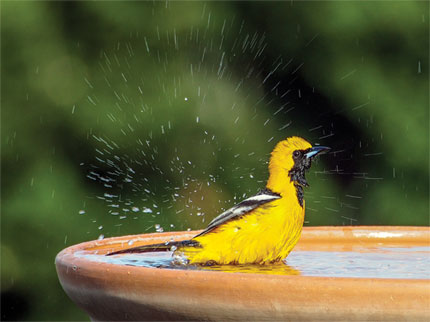
Audubon Adventures

Activities
 Activity 2
Activity 2
Design and Build a Birdbath
 Teacher-led Classroom and Field-based Activity
Teacher-led Classroom and Field-based Activity
Engineering, Science, Research, Design
 How do you make a well-functioning birdbath?
How do you make a well-functioning birdbath?
Objective:
Students work in small teams to design, build, monitor, and refine a birdbath.
Students will need:
- Paper, pencils
- Research materials
- Materials to build the birdbath, chosen by the student; possible choices include:
- Bath: terracotta or plastic planter tray; baking tray; plastic bowl
- Bath support: terracotta or plastic plant pot; plastic bucket; wood; rope
- Rock or brick
- Poster board and pens or computer and printer
Suggested time:
One class period for designing the birdbaths; one class period for building the birdbaths; 10 minutes per day for 1–3 weeks for observations; one class period for documenting/communicating the design
What to do:
- Introduce Guide students to think about the connection between clean fresh water and birds. Why do birds need clean fresh water? What birds live in our neighborhood? Where do they get clean, fresh water? Has anyone observed birds using a puddle, birdbath, or natural body of water? What were they doing?
- Research and Design Explain to students that they will be designing and building a birdbath to place in the schoolyard, a nearby park, or at home. Have students work in small teams to make their plans. Their plans should include the following:
- A sketch showing the parts of the birdbath, its size and shape, and the materials it is made of
- A description or map showing where it should be placed
- What is a birdbath for? What functions does a birdbath need to serve? (A birdbath is used to provide birds with drinking and bathing water. It is also used as a way to attract birds so that people can enjoy them.)
- How will the birds use it? (They will drink out of it and bathe in it.)
- What should it be made out of? What should it not be made out of? (Hint: Think about the conditions the birdbath must be able to withstand outside. Think about what materials will be easiest for birds to stand on.)
- Where should the birdbath be placed so that it is most useful for the birds? (Is it better in the sun or the shade? Out in the open or in the bushes? High up or low on the ground?)
- What are some possible problems that could occur? How could those problems be prevented? (Examples: How will we keep the birdbath from drying out quickly or becoming a place for mosquitoes to breed? How will we keep cats away from it? How will we keep the water clean?) Students may want to consult the “Feed and Water the Birds” article in the Audubon Adventures student magazine, Caretaking Our World’s Water.
- Build and Monitor After reviewing the plans, have students collect the materials they need, and then build and place the baths. Students should then spend some time each day observing. How long did it take birds to find it? What types of birds are using the bath? What are they doing? Do they seem to be having any problems? Guide students to make adjustments if needed to solve any problems with the design.
- Communicate Challenge students to create a how-to poster that shows how to build a birdbath, provides tips for troubleshooting problems with construction or maintenance, and explains the benefits of birdbaths to both birds and people. Posters should include a scaled drawing of the birdbath. These posters can then be displayed next to the birdbaths themselves, in the classroom or other place within the school, or online.
As they plan the design, they should think about the following:
Photos: kahj19/iStock; Larry Miller/Flickr/Creative Commons.




